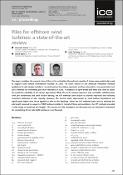Options
Piles for offshore wind turbines: A state of the art review
Author(s)
Date Issued
2011-08-01
Date Available
2013-03-05T15:54:25Z
Abstract
The paper considers the current state of the art for estimating the pull-out capacity of driven open-ended piles used to support wind turbine foundations founded on sand. The latest edition of the American Petroleum Institute guidelines for pile design includes a conventional earth pressure approach and four alternative cone penetration test
(CPT) methods for estimating pile shaft resistance in sand. A database of open-ended pile tests was used to assess the predictive reliability of the design approaches. While the earth pressure approach was unreliable, exhibiting bias with pile slenderness and sand relative density, the CPT methods were shown to provide improved and relatively
consistent estimates of pile capacity. However, the tension loads experienced by wind turbine foundations are significantly higher than those applied to piles in the database. When the CPT methods were used to estimate the pile length required to support a 5 MW turbine installed in typical offshore soil conditions, the CPT methods provided
a wide range of predicted pile lengths. The reasons for this divergence are discussed and an alternative framework for considering driven pile shaft resistance is put forward.
(CPT) methods for estimating pile shaft resistance in sand. A database of open-ended pile tests was used to assess the predictive reliability of the design approaches. While the earth pressure approach was unreliable, exhibiting bias with pile slenderness and sand relative density, the CPT methods were shown to provide improved and relatively
consistent estimates of pile capacity. However, the tension loads experienced by wind turbine foundations are significantly higher than those applied to piles in the database. When the CPT methods were used to estimate the pile length required to support a 5 MW turbine installed in typical offshore soil conditions, the CPT methods provided
a wide range of predicted pile lengths. The reasons for this divergence are discussed and an alternative framework for considering driven pile shaft resistance is put forward.
Type of Material
Journal Article
Publisher
Institution of Civil Engineers
Journal
Proceedings of the ICE - Geotechnical Engineering
Volume
164
Issue
4
Start Page
245
End Page
256
Copyright (Published Version)
2011, ICE Publishing Ltd
Language
English
Status of Item
Peer reviewed
This item is made available under a Creative Commons License
File(s)
Loading...
Name
Piles for offshore wind_2011.pdf
Size
501.49 KB
Format
Adobe PDF
Checksum (MD5)
bdb5a32ff7bf9d4e58b4a2f00f439039
Owning collection